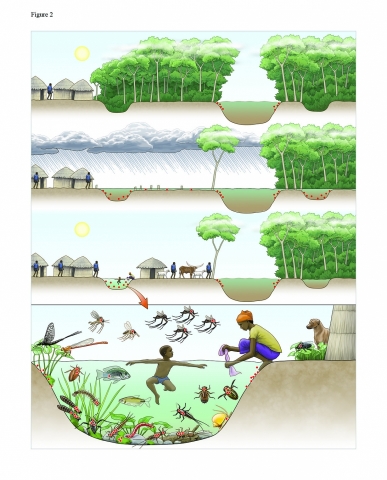
Many emerging infectious diseases are caused by generalist pathogens that infect and transmit via multiple host species with multiple dissemination routes, thus confounding the understanding of pathogen transmission pathways from wildlife reservoirs to humans. The emergence of these pathogens in human populations has frequently been associated with global changes, such as socio-economic, climate or biodiversity modifications, by allowing generalist pathogens to invade and persist in new ecological niches, infect new host species, and thus change the nature of transmission pathways.
Using the case of Buruli ulcer disease, we review* how land-use changes, climatic patterns and biodiversity alterations contribute to disease emergence in many parts of the world. Here we clearly show that Mycobacterium ulcerans is an environmental pathogen characterized by multi-host transmission dynamics and that its infectious pathways to humans rely on the local effects of global environmental changes. We show that the interplay between habitat changes (for example, deforestation and agricultural land-use changes) and climatic patterns (for example, rainfall events), applied in a local context, can lead to abiotic environmental changes and functional changes in local biodiversity that favor the pathogen’s prevalence in the environment and may explain disease emergence.
* Combe M., Velvin C.J., Morris A., Garchitorena A., Carolan K., Sanhueza D., Roche B., Couppié P., Guégan J-F., Gozlan R.E. (2017) The role of socio-economic and climatic changes in Buruli ulcer disease emergence: an ecological perspective Buruli. Emerging Microbes & Infections. 6, e22; doi:10.1038/emi.2017.7
Contact : Marine Combe, postdoctorale researcher IRD (Cayenne) et Rudy Gozlan, directeur de recherche IRD (Cayenne) au sein de l'équipe 7 de l'UMR BOREA
Picture title :
Schematic representation of the links between land-use changes and climatic patterns favoring the emergence of Mycobacterium ulcerans (MU) in the environment. Red dots represent the distribution of MU in the environment (panels 1, 2 and 3) as well as among host carrier species communities (panel 4). The top panel shows a pristine ecosystem with MU in low abundance within the aquatic ecosystem. However, in the second panel, deforestation and climatic events (for example, heavy rain) result in intensive flooding and redistribution of MU in the ecosystem. On the left riverbank, the forest has been cut down, whereas on the right, the ecosystem remains pristine.The third panel shows water receding, thus allowing for the formation of small oxbows, which (when the trees have been cut down) are subjected to higher temperatures, higher biofilm development and lower pH and oxygen levels (conditions that are prone to cause the bacterial proliferation). MU is not established in the shaded oxbow. When associated with an increase in contact rates with humans due to a change in land use, the infectious risk of BU becomes greater. The bacterial distribution in the environment and within a high diversity of hosts suggests multiple routes of transmission to humans. The position of aquatic hosts in the water column illustrates their trophic level, from low trophic level organisms (for example, grazing invertebrates) to higher trophic level organisms (for example, fish). Aquatic organisms of a low trophic level generally present greater bacterial loads compared with organisms of a higher trophic level; zero dots represent the absence of MU, and four dots represent a high MU load. Illustration by Emily S. Damstra.
